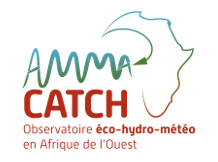Niakhar Complementary Site - Senegal
The Niakhar site is located in central Senegal, in a Sahelian climate. Founded in 1962 in a rural area 150 km from Dakar, in Sereer country, the Niakhar observatory is the oldest population observatory in Africa still in operation (Delaunay et al., 2020). Since its inception, it has monitored the health, demographic, social and economic status of more than two generations.
Since 2018, a long-term Collaborative Observatory on agroforestry ecosystem services (food security, GHG fluxes), has been created by the UMR Eco&Sol, associated with UCAD (Rahimi et al., 2021). Agroforestry in Niakhar is a cultural complex associating an annual millet or groundnut crop with "useful trees", in terms of cash crop and soil enrichment, in this case Faidherbia albida. The "Sob" plot is equipped to study water and carbon balances, associated with the dynamics of herbaceous and woody vegetation (it is part of the Fluxnet network, site Sn-Nkr).
- To equip a second plot "Ragola", cultivated with groundnut or millet in alternation with the plot "Sob", thus allowing to compare two types of agroforestry practices.The measurements set up by AMMA-CATCH on the Ragola plot are : rainfall, meteorology (including energy balance), turbulent fluxes (eddy covariance station) and a moisture profile.
- To distribute the Ragola data and, in time, the Sob data (water and carbon fluxes, sap fluxes, primary production, LAI, phenological stages of trees and their roots, soil moisture and isotopic composition, water table height, soil gas) on the AMMA-CATCH portal.
AMMA-CATCH monitoring of the Ragola plot began in 2018.
"Senegal : Map of instruments deployed on the Niakhar Complementary Site)]
Complementary site : Map of the ferlo site - Senegal
Updated on 26 janvier 2022




